When it came to market nearly a quarter century ago, Santa Fe was Hyundai’s first SUV. Today, it’s part of a broader lineup that runs from the little Venue to the flagship Palisade — but it remains one of the brand’s best sellers. To keep momentum building, the Korean carmaker has given the 2024 Hyundai Santa Fe a complete makeover, starting with the bolder and more classic SUV design. The cabin is not only roomier but adds more upscale details and plenty of welcome tech. And the XRT package now adds more rugged features for those looking to head off-road.

I spent a day driving various versions of the 2024 Hyundai Santa Fe through the Tennessee countryside.
Chances are, the new Hyundai Santa Fe will take you by surprise. Gone is the squishy jellybean styling. Getting a complete makeover for the 2024 model year, the crossover adopts a more rugged and traditional design — though it retains the unibody architecture that gives it a more car-like ride.
The new Santa Fe is now offered exclusively in three-row form and delivers more cargo space and legroom than the outgoing model. The cabin itself has undergone a complete makeover featuring more refined and appealing materials, improved seating and lots of tech touches.
There are new powertrain options, including a hybrid which, unfortunately, won’t be available at launch. But it should be worth waiting for considering it will deliver a full 50% improvement in fuel economy. And it will be offered on all trim levels, including the XRT which has been repositioned as the more rugged option for buyers who might want to do a bit of off-roading.
To get a sense of what the 2024 Hyundai Santa Fe offers, I headed down to Franklin, Tennessee to log a few hundred miles of driving, on and off road.
New design
The 2024 Hyundai Santa Fe delivers one of the most dramatic visual makeovers we’ve seen in recent years. Gone is the soft and squishy look of the outgoing model, replaced by a more classic SUV look. To some, the redesign brings to mind the latest Land Rover design language, others recalling the old Ford Flex.
Surprisingly, the squared-off design of the new Santa Fe is more aerodynamic than the outgoing model, with a drag coefficient of 0.294 compared to 0.33 for the 2023 model.
Design chief Kevin Kang says the new look was heavily influenced by the COVID pandemic, most of the work being done during the early lockdown. “We looked four or five years down the road,” he explained during a briefing earlier this month. “We figured everyone would want to get out,” he added, suggesting the goal was a look that said the new Santa Fe could be used for anything from daily commutes to weekend adventures.
Don’t expect to see the rest of the Hyundai portfolio adopt the same, boxy appearance as the new Santa Fe, cautioned Kang. Unlike other automakers, the brand eschews the “Russian doll” strategy many competitors opt for. That said, it does pick up some familiar cues, such as the distinctive “H” head and taillights.
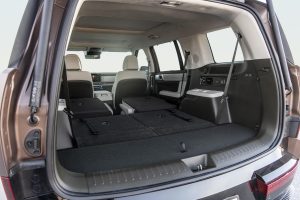
A wider rear opening, a roomier cargo bay and a flat load floor enhance the 2024 Santa Fe’s usability.
Putting a premium on functionality
A closer inspection reveals that the new Santa Fe’s wheelbase has been stretched to 110.8 inches, though it’s only slightly larger overall, Hyundai shrinking the front overhangs. And even after growing 1.7 inches in total length, it’s still about 6 inches shorter than the brand’s flagship Palisade model, at 190.2 inches The 2024 Santa Fe grows 1.4 inches in height, to 67.7 inches, but it holds at 74.8 inches in width.
Kang’s team put an emphasis on functionality. Open the tailgate and you’ll discover the opening to the cargo compartment is now five inches wider and two inches taller than before. And cargo capacity has grown from 36.3 inches to 40.5 cubic feet.
Fold down the second and third rows and you’ll discover a completely flat load floor — which one senior Hyundai official demonstrated by camping out with his wife inside the new Santa Fe.
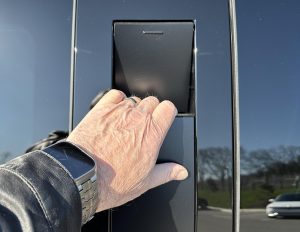
Hand grips above the rear wheels make it easier to climb up to reach cargo stored on the Santa Fe’s roof.
There are plenty of touches that are well thought out, including grips built into the sides directly above the back wheels. You can grab hold and then step up onto the tires, making it easier to access cargo on the roof.
More Reviews
- A Week With: 2024 Kia Seltos SX AWD
- First Drive: 2024 Lincoln Nautilus: Common Scents
- First Drive: Honda’s All-Electric Prologue: A Partnership Pays Off
A well-appointed Interior
Gone are the days when you’d describe Hyundai products as “cheap and cheerful.” Models like the Santa Fe deliver great value for the money — and that’s all the more obvious with the 2024 makeover where features like heated seats are available on lower trim levels than you’ll find with many competitors.
The top-line Calligraphy model that I spent much of my time in was downright lavishly executed, with leather accents and higher-level accents than one might expect in a mainstream SUV.
With the exception of a slightly cramped third row, the cabin is open and airy and large windows provide plenty of outside visibility. The horizontal layout of the instrument panel picks up on the “H” design theme and accentuates the width of the new Santa Fe.
The focus on usability extends to the rest of the cabin, Hyundai adding a new storage bin in the instrument panel that even features a UV sanitizer. The decision to move the wireless shifter to the steering wheel, meanwhile, opens up still more usable space.
New technology
The new Santa Fe offers dual gauge and infotainment screens — the latter measuring up to 12.3 inches on XRT packages and above. One of the new touches is the availability to stream from sources like Amazon Music, with still more services set to follow.
Everyone carries a smartphone these days and it’s great to have a place to put yours down while driving. Bonus points for automakers who’ve begun adding wireless chargers in those dedicated spaces. Hyundai takes things a step further. Depending upon the model, it offers twin, side-by-side 15-watt smartphone chargers.
The 2024 Hyundai Santa Fe offers a wealth of new tech features, including wireless versions of Apple CarPlay and Android Auto, as well as a 4G LTE WiFi hotspot that can connect to up to five devices simultaneously.
If I have any complaints, I’d have liked to see the automaker upgrade to the newer 5G technology — though officials say that could happen in the near future. And while I’m pleased to see the cabin loaded with the latest USB-C ports, I would encourage Honda to go a bit retro and add a couple older USB-A ports as that’s what most folks still use. No need to force customers to have to run out and buy new cables.
Smart tech
Hyundai continues to update its wireless BlueLink technology — which it several years ago made free for first owners to use.
The system offers a wide array of features, including remote starting. One of the new features on the Santa Fe is a Driver Monitoring System which makes sure a motorist is paying attention to the road.
If not, it will advise the driver to put hands back on the wheel. In an emergency, meanwhile, the system will bring the vehicle to a stop, call 911 for help and unlock the doors for emergency responders.
The 2024 Hyundai Santa Fe also adopts the Digital Key system the automaker has begun rolling out on its latest products. Leave the keyfob at home. On trim levels starting with the SEL, the vehicle can be programmed to recognize your smartphone and automatically unlock the doors and let you drive off. You alternatively could use a smart card similar to the ones used by modern hotels.
Picking up on a system first introduced on the latest Kona crossover, Santa Fe also gets the new Hyundai Pay system. Pull up for gas at stations operated by Philips 66, Conoco or 76 and it will automatically pass your billing information to the pump. No need to pull out a credit card and tap in your zipcode. Simply select your fuel grade and start pumping.
New XRT grade
The COVID pandemic kicked off an interesting phenomenon, more and more American motorists heading off-road — or at least saying they want to. We’re seeing a flood of new product targeting this niche, such as the Ford Bronco and the Wilderness trim packages from Subaru.
Now, Hyundai is getting into the game with a repositioned Santa Fe XRT package.
For starters, it gains 1.3 inches of ground clearance, at 8.3 inches. It gets unique wheels and other exterior upgrades. And, for those who plan to get serious off-road, the approach, departure and breakover angles all are increased, to 19.3, 21.8 and 19.1 degrees, respectively. Another plus: improved engine and transmission cooling.
Hyundai planners say they’ll be closely following market response and we could see even more upgrades to the XRT package in the future — as well as off-roadable XRT trims for other future Hyundai products.
Powertrain options

A 2.5-liter turbo-four is available at launch. But Hyundai will follow up with a high-mileage hybrid by mid-year.
Eventually, Hyundai plans to offer two powertrain options for the fifth-generation Santa Fe.
At the moment, however, only a turbocharged 2.5-liter inline-4 engine is available. Paired to an 8-speed automatic, it makes 277 horsepower and 311 pound-feet of torque. It can tow up to 3,500 pounds on most packages — though the XRT grade bumps that to 4,500 pounds.
By late spring, meanwhile, Hyundai will roll out the second powertrain package: a 1.6-liter turbo hybrid rated at 231 hp and 271 lb-ft. It features a 6-speed automatic.
Front and all-wheel-drive options are offered on all packages but the Santa Fe XRT which will be AWD only.
Fuel economy numbers vary but look for up to 20 mpg City, 29 Highway and 24 Combined with the FWD version of the 2.5-liter engine, and up to 36/35/36 with the hybrid, a major increase. All-wheel-drive packages lose 1 mpg Highway and Combined. And the XRT is rated at 19/26/22 by the EPA.
Driving impressions
I spent my day driving two versions of the 2024 Hyundai Santa Fe: the top-end Calligraphy and the XRT, the latter solely on a deeply wooded off-road course.
The AWD versions of the Calligraphy offered reasonable, if not especially thrilling, acceleration. There was more than enough power to execute high-speed freeway passes, though the turbo-four engine did get a bit raspy when my foot slammed the floorboards.
Handling was equally reasonable, though you wouldn’t want to flog the three-row SUV through tight corners. The suspension on the Calligraphy soaked up most bumps but I’d love to see Hyundai add variable dampers in the future. It would be worth the added price.
The new XRT model was surprisingly adept at managing light to moderate trails, thanks to the added ground clearance. It had enough grunt to climb some steep hills and the addition of Hill Descent Control will make it easy for even novices to get around. Again, some further suspension upgrades would be welcome as the current package did create more head tossing than I expected on rough sections of the trail.
Final word
Hyundai has done a solid job upgrading the 2024 Santa Fe. The new design gives it a more rugged appearance while also yielding more interior space for both passengers and cargo.
The three-row layout targets a growing segment of the SUV market and there are enough trim packages to appeal to a variety of buyers, including the newly updated XRT targeting those who may spend occasional trips off-road.
The downside is that you can expect to pay a fair bit more than for the outgoing Santa Fe — which ranged from $30,085 to $49,005 before options and delivery fees. The front-wheel-drive SE package now starts at $33,950, while the top-end Calligraphy with all-wheel-drive jumps to $51,800. The AWD-only XRT starts at $40,600. Add $1,395 in delivery fees.
Even at the higher price level, the 2024 Hyundai Santa Fe is likely to have broad appeal to midsize SUV buyers seeking a well-equipped 3-row package. Compared to many alternatives in the segment, you get a lot for your money.

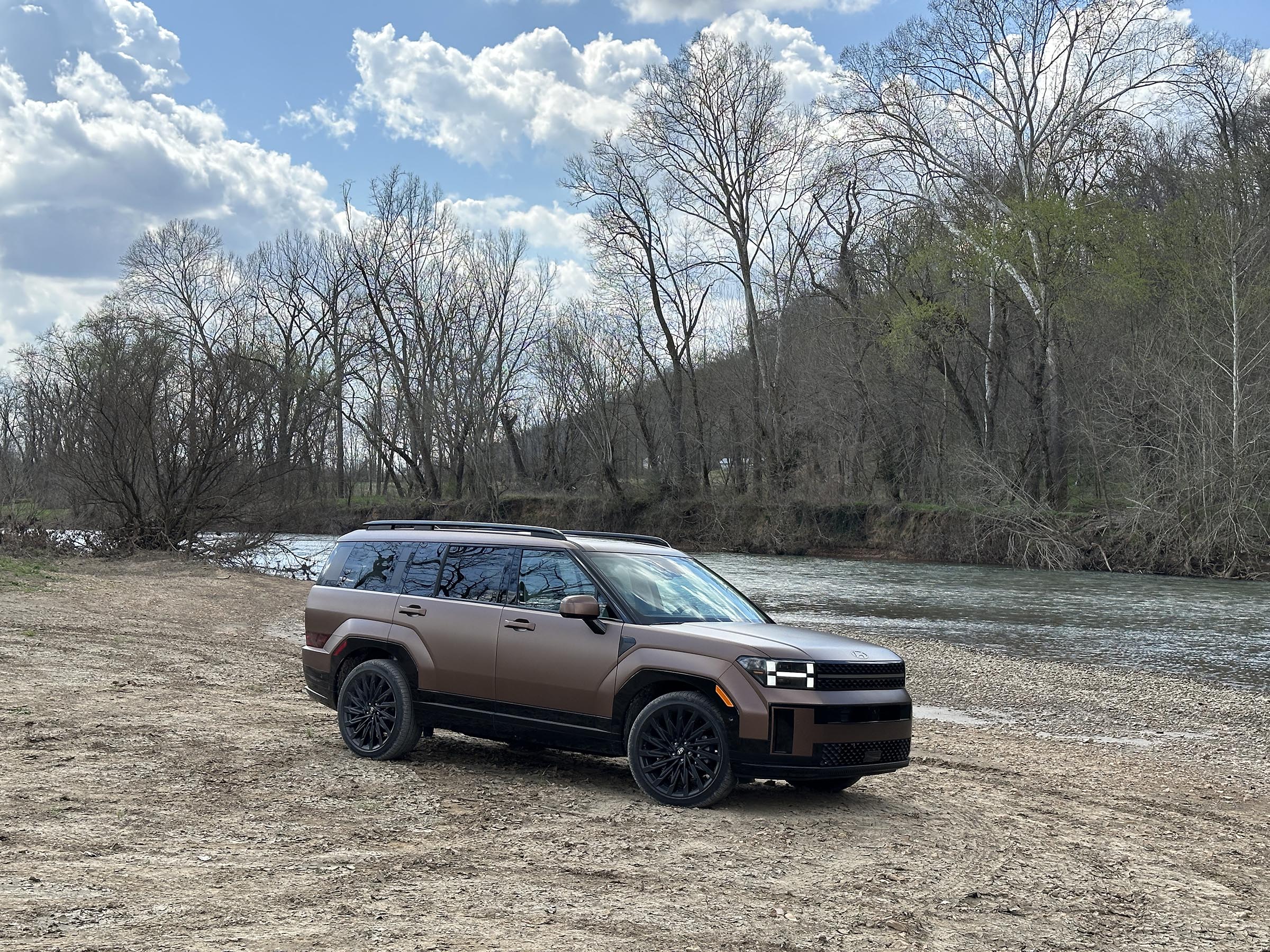



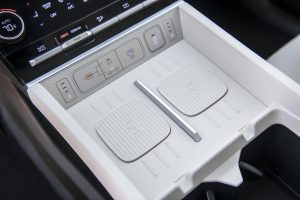
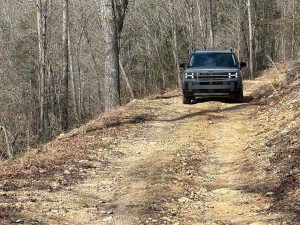
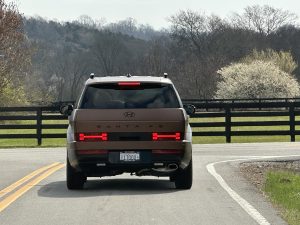
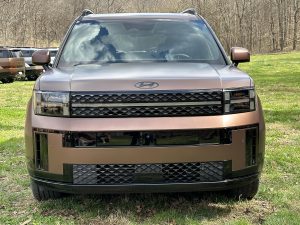
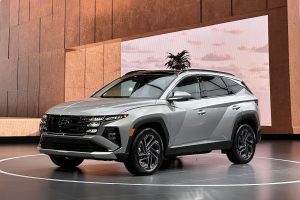
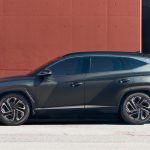

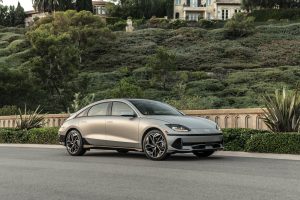

0 Comments